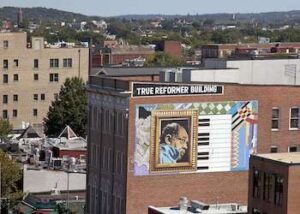
The U Street Corridor
*The U Street Corridor is affirmed on this date in 1862. Sometimes called the Greater U Street or Cardozo/Shaw, it is a neighborhood in Northwest Washington, D.C.
Centered along U Street, one of Washington's most popular nightlife and entertainment districts. It once was one of the country's most significant African American heritage districts. U Street is a largely Victorian-era neighborhood developed between 1862 and 1900 as the Greater U Street historic district. During the American Civil War, the area was covered by woods and open fields.
The Union command used it for military encampments, including Camp Barker near 13th and R streets and others in what is now the Shaw neighborhood. The encampments were safe havens for freed slaves fleeing the South, and thus, the area became a popular one for Blacks to settle. After the war, horse-drawn streetcar lines opened north of downtown Washington along the 7th, 9th, and 14th streets. The lines were later turned into cable cars. Blacks and Whites lived here, gradually shifting to a predominantly Black population between 1900 and 1920. The area's oldest buildings are Italianate, Second Empire, and Queen Anne-style row houses built rapidly by speculative developers in response to the city's high demand for housing with the post-Civil War growth of the federal government.
Until the 1920s, the U Street Corridor was home to the nation's largest urban Black community. The area was home to the Industrial Bank, the city's oldest African American-owned bank, and hundreds of Black-owned and Black-friendly businesses, churches, theaters, gyms, and other community spaces. Natives of the area included jazz musician Duke Ellington, opera singer Lillian Evanti, surgeon Charles R. Drew, and law professor Charles Hamilton Houston. In its cultural heyday, the U Street Corridor was known as "Black Broadway." Performers who played in the local clubs of the era included Cab Calloway, Louis Armstrong, Miles Davis, Sarah Vaughan, Billie Holiday, and Jelly Roll Morton, among many others.
During Prohibition, U Street was also home to many of the capital's 2,000-3,000 speakeasies, which some historians credit for helping integrate a city divided between black and white. From 1911 to 1963, the west end of the U Street neighborhood was by Griffith Stadium, home of the Washington Senators baseball team. The Lincoln Theatre opened in 1921, and the Howard Theatre in 1926. Duke Ellington's childhood home was on 13th Street between T and S Streets. The Green Book listed many sites along U Street N.W. by their travelers.
The area declined following the 1968 Washington Riots but recovered following the 1991 opening of the U Street station of the Washington Metro. Since the 2000s, the area has been subject to significant urban redevelopment and gentrification. This date was chosen due to the Residence Act of 1790, officially titled An Act for establishing the temporary and permanent seat of the Government of the United States, signed into law by President George Washington on this date in 1790.